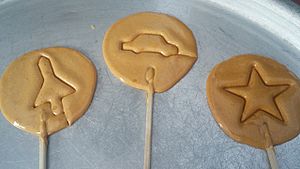Dalgona facts for kids
 |
|
| Alternative names | Ppopgi |
|---|---|
| Type | Sugar candy |
| Place of origin | South Korea |
| Associated national cuisine | Korean cuisine |
| Main ingredients | Sugar, baking soda |
| Similar dishes | Honeycomb toffee |
| Korean name | |
| Hangul |
달고나
|
|---|---|
| Revised Romanization | dalgona |
| McCune–Reischauer | talgona |
| IPA | [tal.ɡo.na] |
| Alternative name | |
| Hangul |
뽑기
|
| Revised Romanization | ppopgi |
| McCune–Reischauer | ppopki |
| IPA | [p͈op̚.k͈i] |
Dalgona (Hangul: 달고나) or ppopgi (Hangul: 뽑기) is a Korean candy made with melted sugar and baking soda. It was a popular street snack in the 1970s and 1980s, and is still eaten as a retro food. When a pinch of baking soda is mixed into melted sugar, the thermal decomposition of the baking soda releases carbon dioxide, which makes the liquidized sugar puff up, and it becomes a light and crunchy candy once cooled and hardened. Typically, the creamy beige liquid is poured on a flat surface, pressed flat, and stamped with a patterned mold. Eaters try to trim their way around the outline or picture on the snack without breaking the picture. Traditionally, if this trimming is completed without breaking the candy, the consumer receives another free dalgona.
Modern cafes in Korea serve novel dalgona coffee beverages where dalgona-flavoured coffee cream is heaped on top of iced tea or coffee, as well as pastries such as scones. Some cafes also used dalgona to launch desserts such as bingsu and souffle.
Dalgona appeared in an episode of the Netflix series Squid Game, with a deadly version of the dalgona challenge being the second game played in the series. The success of the series led to a revival of the candy's popularity in South Korea and around the world, and sales doubled for street vendors. People have also taken to social media to make their own candy at home as a challenge.
Name
Dalgona was originally a term specific for expensive candies that use glucose which did not use a mold, while ppopgi was originally candies that use sugar and thus could be easily molded into shapes such as stars and circles. Due to problems with dalgona regarding its susceptibility to mould, the word dalgona began to refer to the same food as ppopgi. In Gyeonggi Province, including Seoul and Incheon, it was mainly called dalgona and ppopgi, but the names vary from region to region.
- ttigi (띠기): Representatively, it was used in Daejeon, and other regions were used in most of Chungcheong Province except Cheongju and most of Jeolla Province except Gwangju. Ttigi reflects the characteristics of Chungcheong and Jeolla dialects in which the vowel e(ㅔ) is converted into i(ㅣ), and when changed to a standard language, it becomes ttegi(떼기).
- gukja (국자): It was mainly used in Daegu and North Gyeongsang Province, and it is said to have been called a gukja (ladle) because it was made and eaten in a ladle. In addition, it was also called pajjakkung (파짜꿍), but it is not as strong as a gukja.
- jjokja (쪽자): It was mainly used in the South Gyeongsang Province, and it is presumed to have originated from the dialect of the ladle, but it is not accurate.
- orittegi / orittigi (오리떼기/오리띠기): It was mainly used in Masan and is said to have originated from the dialect of "cutting (오려|oreo) and pulling (떼기|ttegi)".
- ttong-gwaja (똥과자): In Busan, it is said that it was also called ttong-gwaja in addition to jjokja. As the name suggests, it was called ttong-gwaja (poop cookie) because it looked like a poop.
- ttegi (떼기): It is said that in Jeju Island, like Chungcheong and Jeolla, it was called ttegi by borrowing the standard language itself without transforming it into ttigi, a dialect form. Exceptionally, it is said that it was also called tikka (띠까) in some areas of Seogwipo.
From the 1970-80s to the early 2000s, when the popularity of ppopgi was in full swing, the media had little influence, so the names were different for each region. However, generations later, the spread of smartphones and the influence of the media have increased, and the influence of the Seoul/Gyeonggi region, which is naturally exposed to the media, has increased. Since then, these regional names have lost their power, and most middle and high school students now simply call them dalgona.
Gallery
-
Making dalgona on yeontan (coal briquettes)
See also
 In Spanish: Dalgona para niños
In Spanish: Dalgona para niños






